Dissertation Proposal: John Lewis E-commerce Strategic Analysis
VerifiedAdded on 2020/06/06
|7
|1428
|28
Project
AI Summary
This dissertation proposal outlines a study aimed at identifying the strategic analysis of the UK e-commerce fashion retail industry, with a specific focus on John Lewis. The introduction provides an overview, rationale, research aim, objectives, and questions. The literature review explores existing research on e-commerce and strategic applications. The methodology section details the descriptive investigation type, data collection methods (primary and secondary), sampling, ethical considerations, data analysis plan, and limitations. Anticipated findings include insights into strategic options, factors affecting e-commerce, tools for measuring success, and recommendations for improving John Lewis's performance. A detailed timetable is provided, outlining key activities across a 12-week period. The proposal concludes with a comprehensive list of references, including books, journals, and online resources, supporting the research's foundation.

Dissertation Proposal
Paraphrase This Document
Need a fresh take? Get an instant paraphrase of this document with our AI Paraphraser
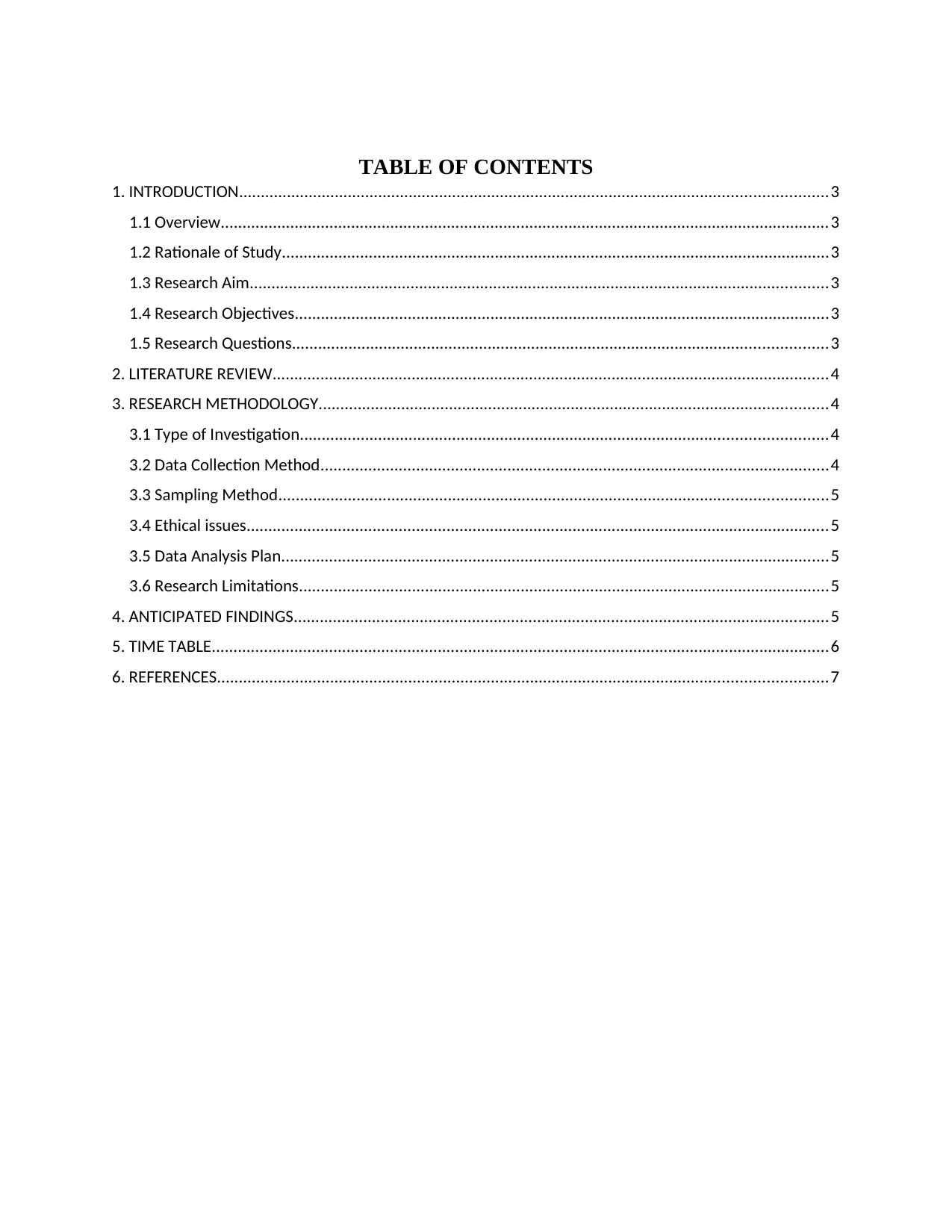
TABLE OF CONTENTS
1. INTRODUCTION.......................................................................................................................................3
1.1 Overview............................................................................................................................................3
1.2 Rationale of Study..............................................................................................................................3
1.3 Research Aim.....................................................................................................................................3
1.4 Research Objectives...........................................................................................................................3
1.5 Research Questions...........................................................................................................................3
2. LITERATURE REVIEW................................................................................................................................4
3. RESEARCH METHODOLOGY.....................................................................................................................4
3.1 Type of Investigation.........................................................................................................................4
3.2 Data Collection Method.....................................................................................................................4
3.3 Sampling Method..............................................................................................................................5
3.4 Ethical issues......................................................................................................................................5
3.5 Data Analysis Plan..............................................................................................................................5
3.6 Research Limitations..........................................................................................................................5
4. ANTICIPATED FINDINGS...........................................................................................................................5
5. TIME TABLE..............................................................................................................................................6
6. REFERENCES............................................................................................................................................7
1. INTRODUCTION.......................................................................................................................................3
1.1 Overview............................................................................................................................................3
1.2 Rationale of Study..............................................................................................................................3
1.3 Research Aim.....................................................................................................................................3
1.4 Research Objectives...........................................................................................................................3
1.5 Research Questions...........................................................................................................................3
2. LITERATURE REVIEW................................................................................................................................4
3. RESEARCH METHODOLOGY.....................................................................................................................4
3.1 Type of Investigation.........................................................................................................................4
3.2 Data Collection Method.....................................................................................................................4
3.3 Sampling Method..............................................................................................................................5
3.4 Ethical issues......................................................................................................................................5
3.5 Data Analysis Plan..............................................................................................................................5
3.6 Research Limitations..........................................................................................................................5
4. ANTICIPATED FINDINGS...........................................................................................................................5
5. TIME TABLE..............................................................................................................................................6
6. REFERENCES............................................................................................................................................7
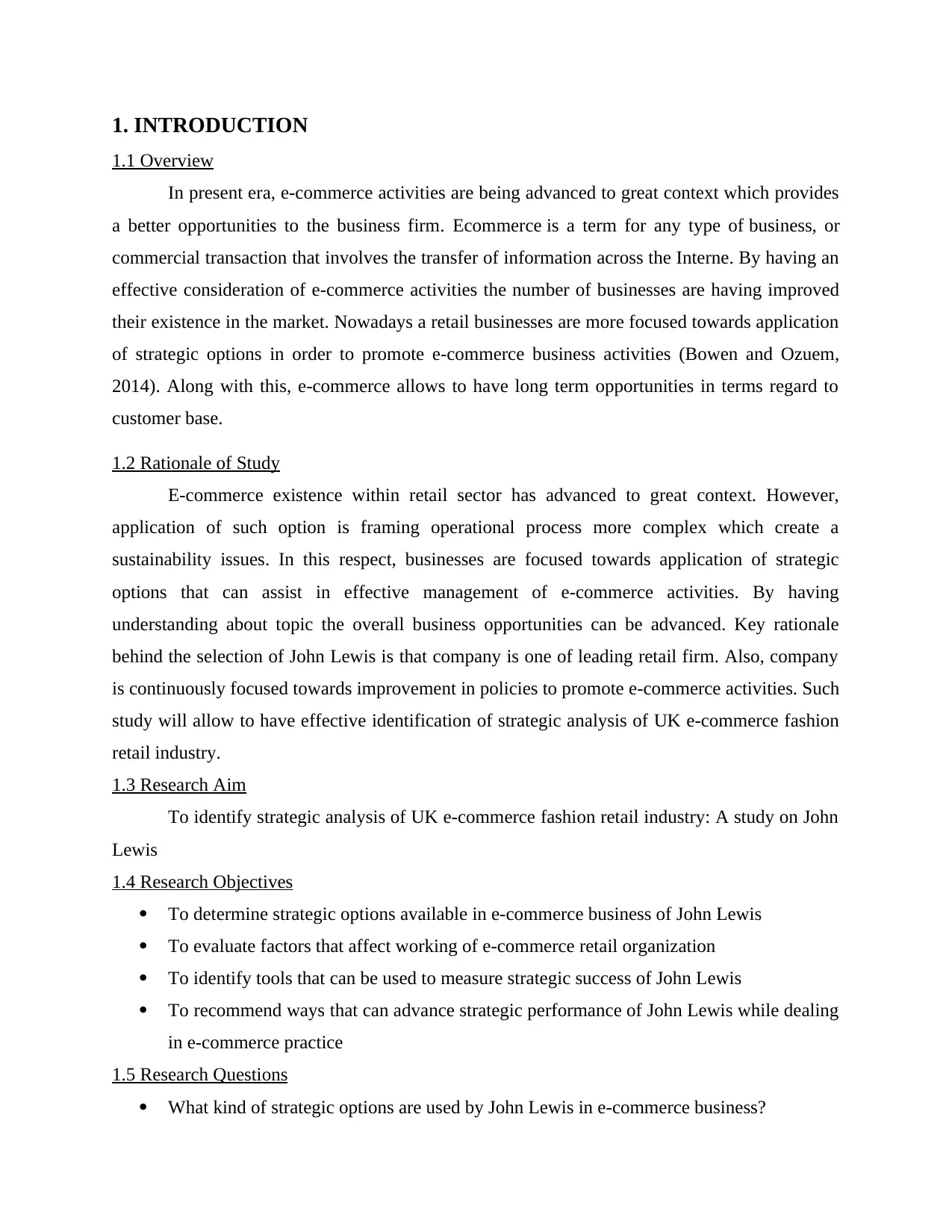
1. INTRODUCTION
1.1 Overview
In present era, e-commerce activities are being advanced to great context which provides
a better opportunities to the business firm. Ecommerce is a term for any type of business, or
commercial transaction that involves the transfer of information across the Interne. By having an
effective consideration of e-commerce activities the number of businesses are having improved
their existence in the market. Nowadays a retail businesses are more focused towards application
of strategic options in order to promote e-commerce business activities (Bowen and Ozuem,
2014). Along with this, e-commerce allows to have long term opportunities in terms regard to
customer base.
1.2 Rationale of Study
E-commerce existence within retail sector has advanced to great context. However,
application of such option is framing operational process more complex which create a
sustainability issues. In this respect, businesses are focused towards application of strategic
options that can assist in effective management of e-commerce activities. By having
understanding about topic the overall business opportunities can be advanced. Key rationale
behind the selection of John Lewis is that company is one of leading retail firm. Also, company
is continuously focused towards improvement in policies to promote e-commerce activities. Such
study will allow to have effective identification of strategic analysis of UK e-commerce fashion
retail industry.
1.3 Research Aim
To identify strategic analysis of UK e-commerce fashion retail industry: A study on John
Lewis
1.4 Research Objectives
To determine strategic options available in e-commerce business of John Lewis
To evaluate factors that affect working of e-commerce retail organization
To identify tools that can be used to measure strategic success of John Lewis
To recommend ways that can advance strategic performance of John Lewis while dealing
in e-commerce practice
1.5 Research Questions
What kind of strategic options are used by John Lewis in e-commerce business?
1.1 Overview
In present era, e-commerce activities are being advanced to great context which provides
a better opportunities to the business firm. Ecommerce is a term for any type of business, or
commercial transaction that involves the transfer of information across the Interne. By having an
effective consideration of e-commerce activities the number of businesses are having improved
their existence in the market. Nowadays a retail businesses are more focused towards application
of strategic options in order to promote e-commerce business activities (Bowen and Ozuem,
2014). Along with this, e-commerce allows to have long term opportunities in terms regard to
customer base.
1.2 Rationale of Study
E-commerce existence within retail sector has advanced to great context. However,
application of such option is framing operational process more complex which create a
sustainability issues. In this respect, businesses are focused towards application of strategic
options that can assist in effective management of e-commerce activities. By having
understanding about topic the overall business opportunities can be advanced. Key rationale
behind the selection of John Lewis is that company is one of leading retail firm. Also, company
is continuously focused towards improvement in policies to promote e-commerce activities. Such
study will allow to have effective identification of strategic analysis of UK e-commerce fashion
retail industry.
1.3 Research Aim
To identify strategic analysis of UK e-commerce fashion retail industry: A study on John
Lewis
1.4 Research Objectives
To determine strategic options available in e-commerce business of John Lewis
To evaluate factors that affect working of e-commerce retail organization
To identify tools that can be used to measure strategic success of John Lewis
To recommend ways that can advance strategic performance of John Lewis while dealing
in e-commerce practice
1.5 Research Questions
What kind of strategic options are used by John Lewis in e-commerce business?
⊘ This is a preview!⊘
Do you want full access?
Subscribe today to unlock all pages.

Trusted by 1+ million students worldwide
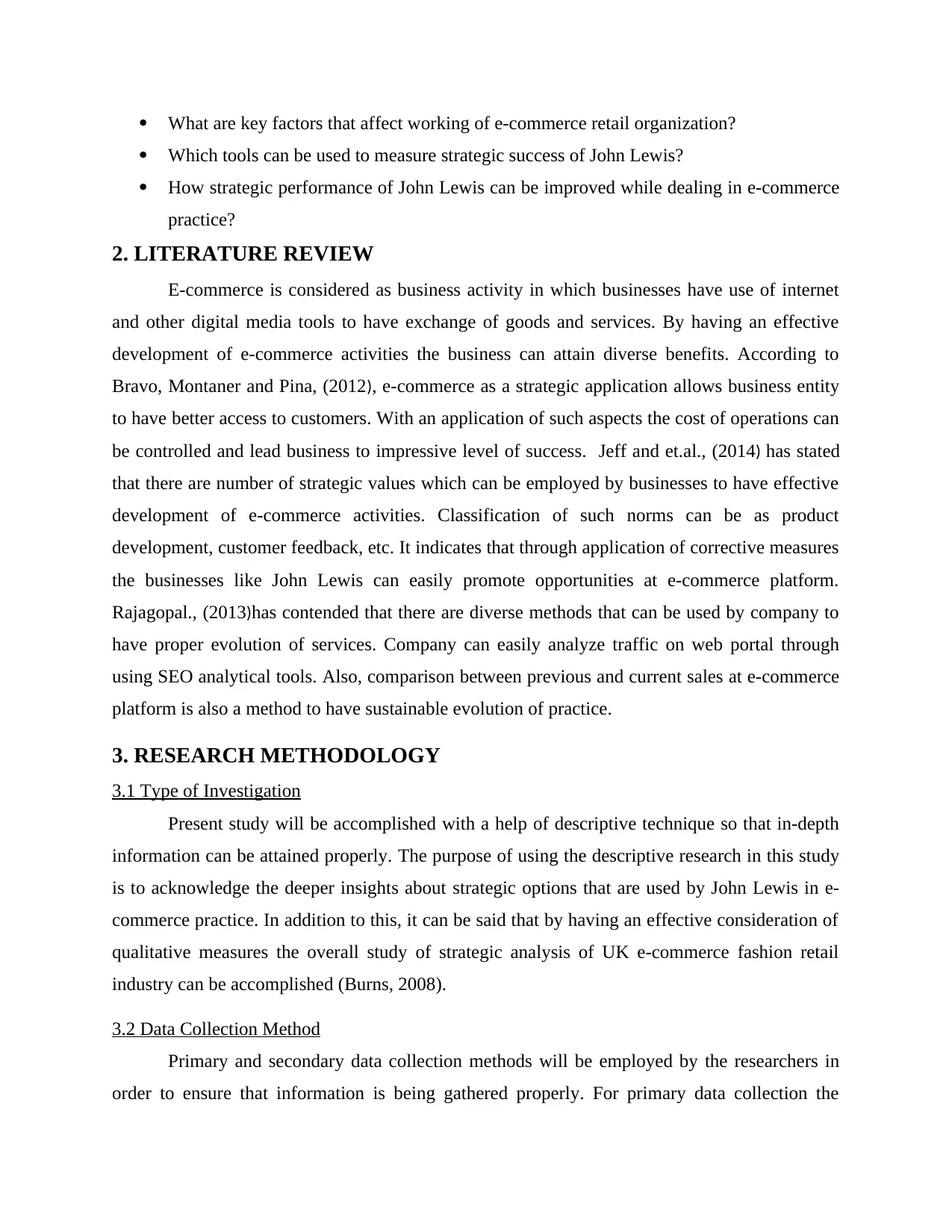
What are key factors that affect working of e-commerce retail organization?
Which tools can be used to measure strategic success of John Lewis?
How strategic performance of John Lewis can be improved while dealing in e-commerce
practice?
2. LITERATURE REVIEW
E-commerce is considered as business activity in which businesses have use of internet
and other digital media tools to have exchange of goods and services. By having an effective
development of e-commerce activities the business can attain diverse benefits. According to
Bravo, Montaner and Pina, (2012), e-commerce as a strategic application allows business entity
to have better access to customers. With an application of such aspects the cost of operations can
be controlled and lead business to impressive level of success. Jeff and et.al., (2014) has stated
that there are number of strategic values which can be employed by businesses to have effective
development of e-commerce activities. Classification of such norms can be as product
development, customer feedback, etc. It indicates that through application of corrective measures
the businesses like John Lewis can easily promote opportunities at e-commerce platform.
Rajagopal., (2013)has contended that there are diverse methods that can be used by company to
have proper evolution of services. Company can easily analyze traffic on web portal through
using SEO analytical tools. Also, comparison between previous and current sales at e-commerce
platform is also a method to have sustainable evolution of practice.
3. RESEARCH METHODOLOGY
3.1 Type of Investigation
Present study will be accomplished with a help of descriptive technique so that in-depth
information can be attained properly. The purpose of using the descriptive research in this study
is to acknowledge the deeper insights about strategic options that are used by John Lewis in e-
commerce practice. In addition to this, it can be said that by having an effective consideration of
qualitative measures the overall study of strategic analysis of UK e-commerce fashion retail
industry can be accomplished (Burns, 2008).
3.2 Data Collection Method
Primary and secondary data collection methods will be employed by the researchers in
order to ensure that information is being gathered properly. For primary data collection the
Which tools can be used to measure strategic success of John Lewis?
How strategic performance of John Lewis can be improved while dealing in e-commerce
practice?
2. LITERATURE REVIEW
E-commerce is considered as business activity in which businesses have use of internet
and other digital media tools to have exchange of goods and services. By having an effective
development of e-commerce activities the business can attain diverse benefits. According to
Bravo, Montaner and Pina, (2012), e-commerce as a strategic application allows business entity
to have better access to customers. With an application of such aspects the cost of operations can
be controlled and lead business to impressive level of success. Jeff and et.al., (2014) has stated
that there are number of strategic values which can be employed by businesses to have effective
development of e-commerce activities. Classification of such norms can be as product
development, customer feedback, etc. It indicates that through application of corrective measures
the businesses like John Lewis can easily promote opportunities at e-commerce platform.
Rajagopal., (2013)has contended that there are diverse methods that can be used by company to
have proper evolution of services. Company can easily analyze traffic on web portal through
using SEO analytical tools. Also, comparison between previous and current sales at e-commerce
platform is also a method to have sustainable evolution of practice.
3. RESEARCH METHODOLOGY
3.1 Type of Investigation
Present study will be accomplished with a help of descriptive technique so that in-depth
information can be attained properly. The purpose of using the descriptive research in this study
is to acknowledge the deeper insights about strategic options that are used by John Lewis in e-
commerce practice. In addition to this, it can be said that by having an effective consideration of
qualitative measures the overall study of strategic analysis of UK e-commerce fashion retail
industry can be accomplished (Burns, 2008).
3.2 Data Collection Method
Primary and secondary data collection methods will be employed by the researchers in
order to ensure that information is being gathered properly. For primary data collection the
Paraphrase This Document
Need a fresh take? Get an instant paraphrase of this document with our AI Paraphraser
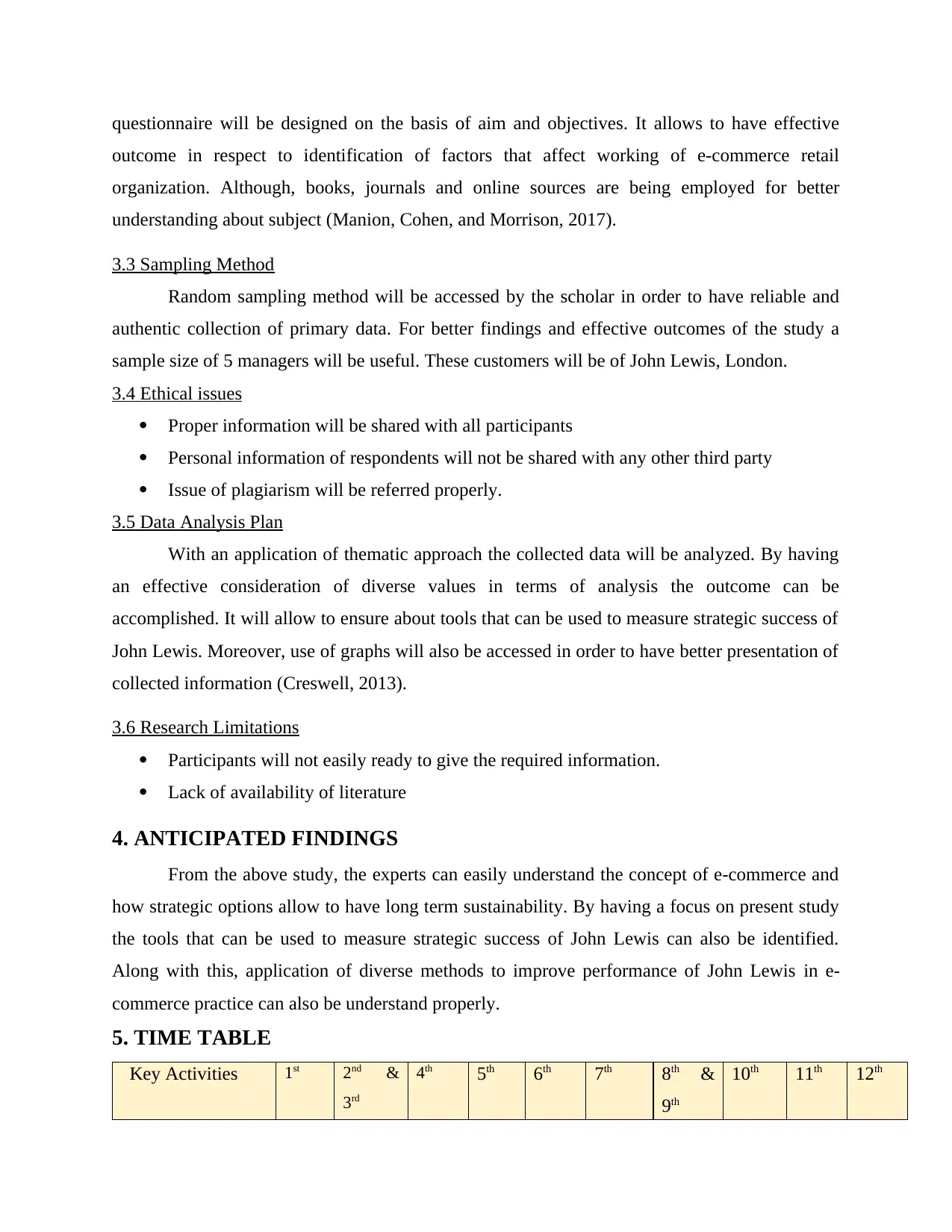
questionnaire will be designed on the basis of aim and objectives. It allows to have effective
outcome in respect to identification of factors that affect working of e-commerce retail
organization. Although, books, journals and online sources are being employed for better
understanding about subject (Manion, Cohen, and Morrison, 2017).
3.3 Sampling Method
Random sampling method will be accessed by the scholar in order to have reliable and
authentic collection of primary data. For better findings and effective outcomes of the study a
sample size of 5 managers will be useful. These customers will be of John Lewis, London.
3.4 Ethical issues
Proper information will be shared with all participants
Personal information of respondents will not be shared with any other third party
Issue of plagiarism will be referred properly.
3.5 Data Analysis Plan
With an application of thematic approach the collected data will be analyzed. By having
an effective consideration of diverse values in terms of analysis the outcome can be
accomplished. It will allow to ensure about tools that can be used to measure strategic success of
John Lewis. Moreover, use of graphs will also be accessed in order to have better presentation of
collected information (Creswell, 2013).
3.6 Research Limitations
Participants will not easily ready to give the required information.
Lack of availability of literature
4. ANTICIPATED FINDINGS
From the above study, the experts can easily understand the concept of e-commerce and
how strategic options allow to have long term sustainability. By having a focus on present study
the tools that can be used to measure strategic success of John Lewis can also be identified.
Along with this, application of diverse methods to improve performance of John Lewis in e-
commerce practice can also be understand properly.
5. TIME TABLE
Key Activities 1st 2nd &
3rd
4th 5th 6th 7th 8th &
9th
10th 11th 12th
outcome in respect to identification of factors that affect working of e-commerce retail
organization. Although, books, journals and online sources are being employed for better
understanding about subject (Manion, Cohen, and Morrison, 2017).
3.3 Sampling Method
Random sampling method will be accessed by the scholar in order to have reliable and
authentic collection of primary data. For better findings and effective outcomes of the study a
sample size of 5 managers will be useful. These customers will be of John Lewis, London.
3.4 Ethical issues
Proper information will be shared with all participants
Personal information of respondents will not be shared with any other third party
Issue of plagiarism will be referred properly.
3.5 Data Analysis Plan
With an application of thematic approach the collected data will be analyzed. By having
an effective consideration of diverse values in terms of analysis the outcome can be
accomplished. It will allow to ensure about tools that can be used to measure strategic success of
John Lewis. Moreover, use of graphs will also be accessed in order to have better presentation of
collected information (Creswell, 2013).
3.6 Research Limitations
Participants will not easily ready to give the required information.
Lack of availability of literature
4. ANTICIPATED FINDINGS
From the above study, the experts can easily understand the concept of e-commerce and
how strategic options allow to have long term sustainability. By having a focus on present study
the tools that can be used to measure strategic success of John Lewis can also be identified.
Along with this, application of diverse methods to improve performance of John Lewis in e-
commerce practice can also be understand properly.
5. TIME TABLE
Key Activities 1st 2nd &
3rd
4th 5th 6th 7th 8th &
9th
10th 11th 12th
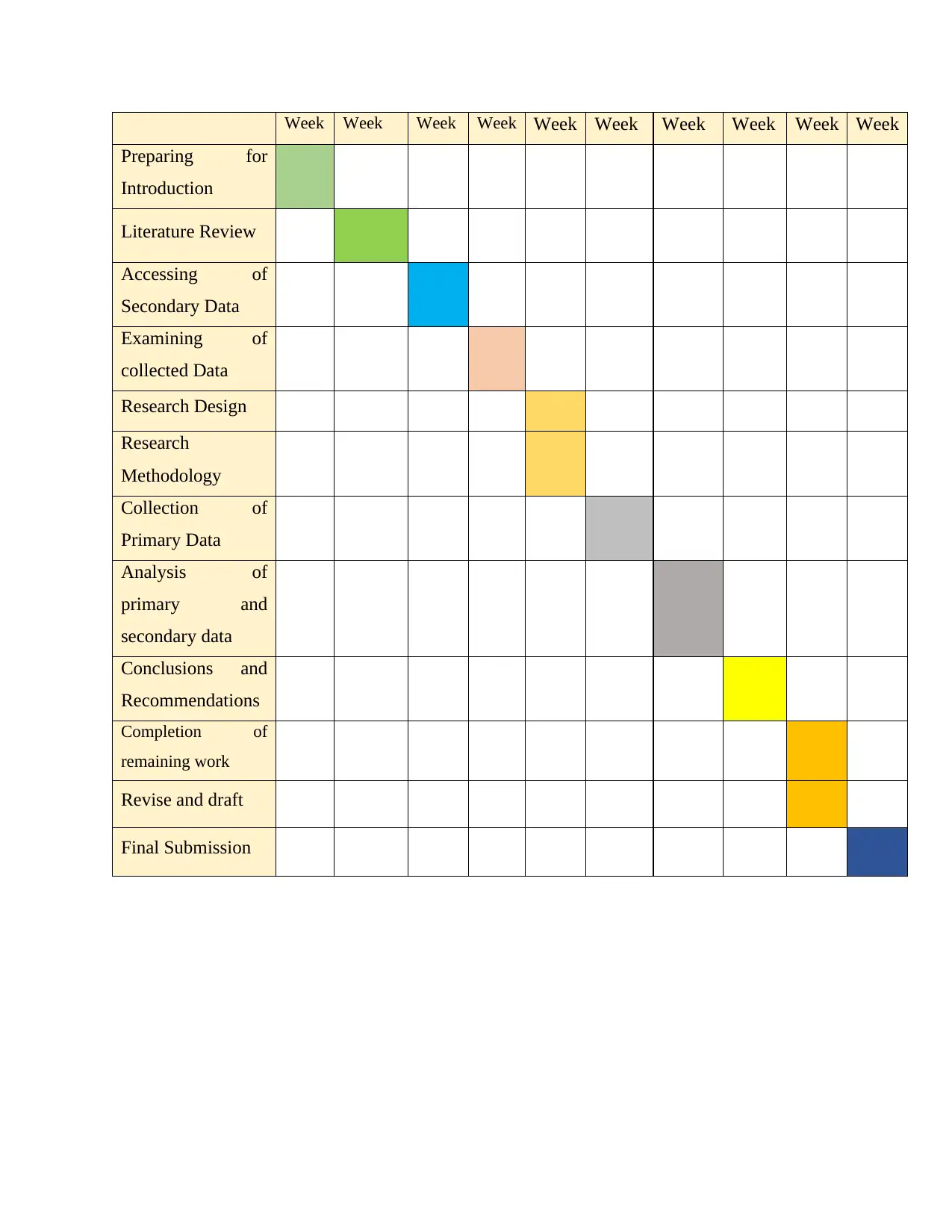
Week Week Week Week Week Week Week Week Week Week
Preparing for
Introduction
Literature Review
Accessing of
Secondary Data
Examining of
collected Data
Research Design
Research
Methodology
Collection of
Primary Data
Analysis of
primary and
secondary data
Conclusions and
Recommendations
Completion of
remaining work
Revise and draft
Final Submission
Preparing for
Introduction
Literature Review
Accessing of
Secondary Data
Examining of
collected Data
Research Design
Research
Methodology
Collection of
Primary Data
Analysis of
primary and
secondary data
Conclusions and
Recommendations
Completion of
remaining work
Revise and draft
Final Submission
⊘ This is a preview!⊘
Do you want full access?
Subscribe today to unlock all pages.

Trusted by 1+ million students worldwide
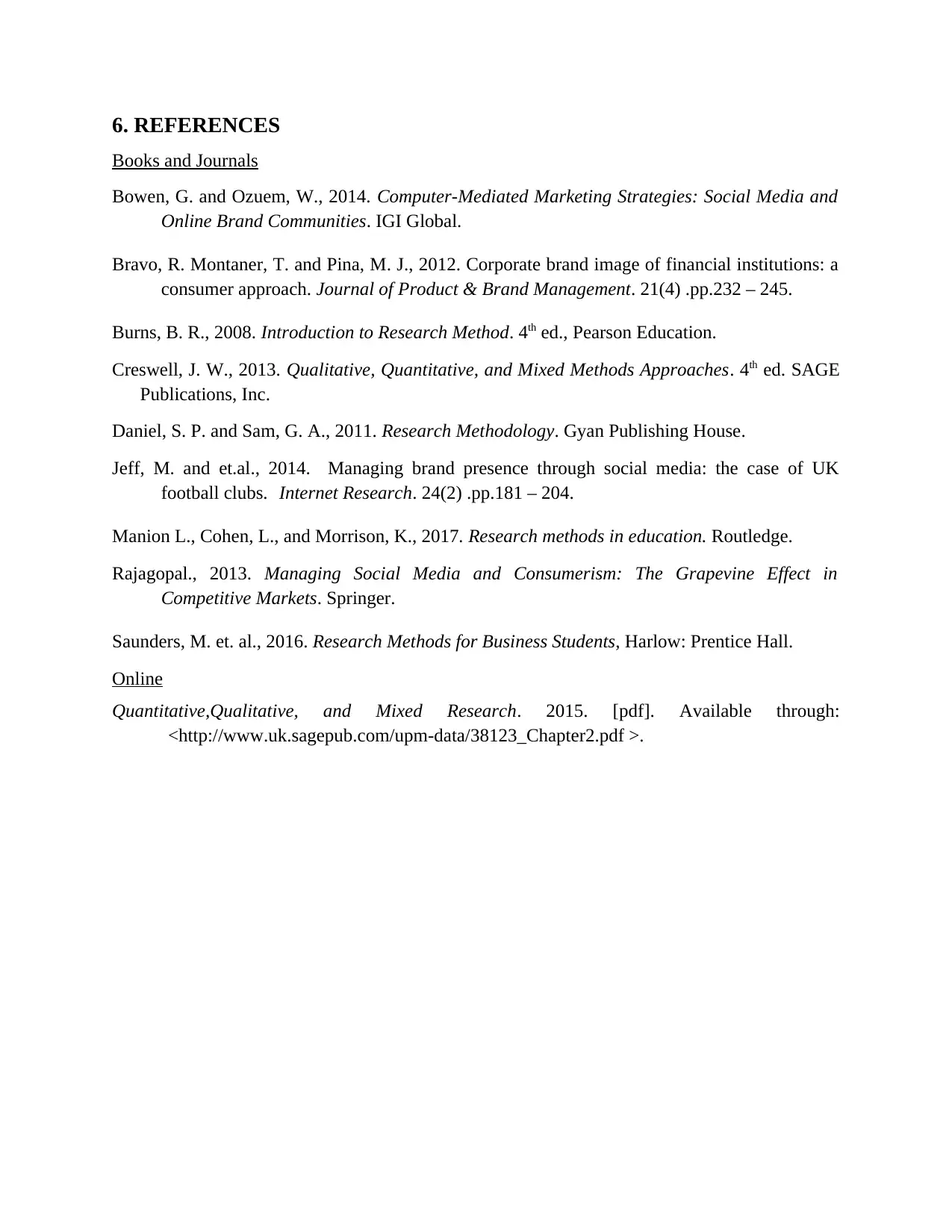
6. REFERENCES
Books and Journals
Bowen, G. and Ozuem, W., 2014. Computer-Mediated Marketing Strategies: Social Media and
Online Brand Communities. IGI Global.
Bravo, R. Montaner, T. and Pina, M. J., 2012. Corporate brand image of financial institutions: a
consumer approach. Journal of Product & Brand Management. 21(4) .pp.232 – 245.
Burns, B. R., 2008. Introduction to Research Method. 4th ed., Pearson Education.
Creswell, J. W., 2013. Qualitative, Quantitative, and Mixed Methods Approaches. 4th ed. SAGE
Publications, Inc.
Daniel, S. P. and Sam, G. A., 2011. Research Methodology. Gyan Publishing House.
Jeff, M. and et.al., 2014. Managing brand presence through social media: the case of UK
football clubs. Internet Research. 24(2) .pp.181 – 204.
Manion L., Cohen, L., and Morrison, K., 2017. Research methods in education. Routledge.
Rajagopal., 2013. Managing Social Media and Consumerism: The Grapevine Effect in
Competitive Markets. Springer.
Saunders, M. et. al., 2016. Research Methods for Business Students, Harlow: Prentice Hall.
Online
Quantitative,Qualitative, and Mixed Research. 2015. [pdf]. Available through:
<http://www.uk.sagepub.com/upm-data/38123_Chapter2.pdf >.
Books and Journals
Bowen, G. and Ozuem, W., 2014. Computer-Mediated Marketing Strategies: Social Media and
Online Brand Communities. IGI Global.
Bravo, R. Montaner, T. and Pina, M. J., 2012. Corporate brand image of financial institutions: a
consumer approach. Journal of Product & Brand Management. 21(4) .pp.232 – 245.
Burns, B. R., 2008. Introduction to Research Method. 4th ed., Pearson Education.
Creswell, J. W., 2013. Qualitative, Quantitative, and Mixed Methods Approaches. 4th ed. SAGE
Publications, Inc.
Daniel, S. P. and Sam, G. A., 2011. Research Methodology. Gyan Publishing House.
Jeff, M. and et.al., 2014. Managing brand presence through social media: the case of UK
football clubs. Internet Research. 24(2) .pp.181 – 204.
Manion L., Cohen, L., and Morrison, K., 2017. Research methods in education. Routledge.
Rajagopal., 2013. Managing Social Media and Consumerism: The Grapevine Effect in
Competitive Markets. Springer.
Saunders, M. et. al., 2016. Research Methods for Business Students, Harlow: Prentice Hall.
Online
Quantitative,Qualitative, and Mixed Research. 2015. [pdf]. Available through:
<http://www.uk.sagepub.com/upm-data/38123_Chapter2.pdf >.
1 out of 7
Related Documents
Your All-in-One AI-Powered Toolkit for Academic Success.
+13062052269
info@desklib.com
Available 24*7 on WhatsApp / Email
![[object Object]](/_next/static/media/star-bottom.7253800d.svg)
Unlock your academic potential
Copyright © 2020–2025 A2Z Services. All Rights Reserved. Developed and managed by ZUCOL.




